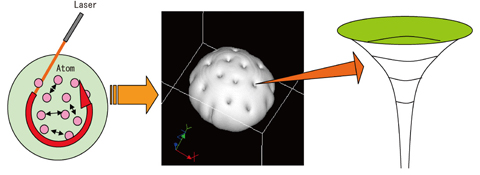
Fig.10-3
It is said that "room temperature superconductivity may cause a revolution much beyond the Industrial Revolution". Zero electrical resistance at the room temperature would allow transfer of energy created by an electric power plant without any loss, a global electrical energy transport, a high-speed transportation network by linear motor car, a laptop parallel supercomputer without any coolers and so on. Due to such great possibilities, to raise the superconducting transition temperature up to the room temperature range is a dream of scientists today.
Very recently, study of the room temperature superconducting state is being attempted even though it has been not discovered yet. This is because the superfluidity in the atomic Fermi gas realized on 2004, is a very strong coupling superfluidity whose impact would be equal to room temperature superconductivity. In general, the superconductivity emerges when two electrons form a pair via an attractive interaction. The strength of this attraction is known to determine the superconductivity transition temperature. The attractive interaction in the atomic Fermi gas is so strong that the attraction causes the superconductivity in a 1000K range much beyond the room temperature. This fact raises a question of what features the strong superfluid state has, and especially, what structure the vortex seen in the superfluid flow exhibits. The vortex has a key role in both superfluid and superconductivity since its motion imposes a limitation on dissipation-free flow. Thus, one must inevitably study the vortex structure and its dynamics when considering the application of superconductivity.
In this study, we determined the vortex structure by a first-principle calculation, and succeeded in finding the structure from weak to strong attractive interaction beyond that of room temperature superconductivity. As a consequence, it is found that the strong attraction leads to drastically lowered atom-density inside the vortex core like the depression in the middle of water inside a bucket when rotated, whereas in contrast there is little density depression in the weak attraction. This result indicates that the electrical transport capacity of the room temperature superconductor will be great. We confirm through this study that the room temperature superconductivity may be quite fruitful if it is realized.
<Previous: 10 Computational Science and E-Systems Research | Next: 10-3 >